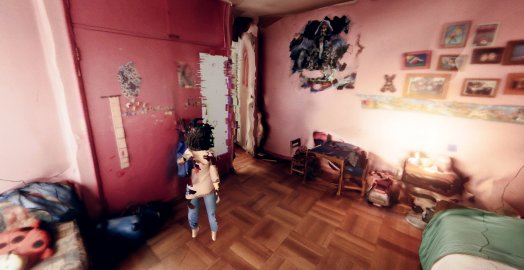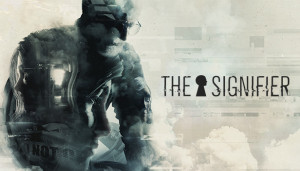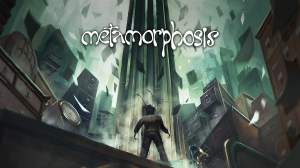Review for The Signifier

Playmestudio’s The Signifier charts its own course by taking players, in science fiction fashion, into the memories of a deceased executive for a prominent AI tech company. Part detective story, part sociopolitical thriller, this is a surreal tale with high ambitions. While the final results are decidedly mixed, the distinct visual and just-weird-enough experience manage to carry it through its rough patches.
You play as Russell, a near-future scientific researcher who uses an artificial intelligence named Evee and special neurological equipment to research the human mind by generating explorable, interactive visions of the subject’s memories. With the confluence of AI, social media and brain scanning, a new oversight authority called the Technology Safeguard Bureau has emerged as a watchdog group and is keeping an eye on the moral, ethical, and privacy issues of Russell’s work. But when Johanna Kast, a top executive for the leading AI company, Go-AT, turns up dead in her apartment of an apparent drug overdose, the TSB show up at Russell’s doorstep to pressure him into using his technology to dig into the circumstances surrounding her death.
Over the course of five chapters and six hours of gameplay, you’ll explore Johanna’s past in your own unique way. Working out of an old brick warehouse, Russell has developed a machine that allows him to enter select scenes from Johanna’s memories. Initially, only a moment from shortly before her death is available. However, as you proceed, more memories are unlocked from different sources both within Johanna’s memories and the real world.
Your investigation into how Johanna died quickly expands into a greater prying into her life in general, with several twists and turns, some that strike uncomfortably close to home for Russell. Questions arise as to whether Johanna’s death was suicide or something more nefarious. At the same time, larger sociopolitical concerns come into play. Go-AT becomes interested in hiring Russell for his groundbreaking work into neural visualization, although as they’re aware of his probe they may have ulterior motives. At the same time, the TSB are breathing down Russell’s neck to come up with Johanna’s password so they can access her secure information for anything that might be important in relation to her death – or possibly to any illicit activities on Go-AT’s behalf.
The game does a good job of slowly building up the mystery and developing a number of conspiracy theories hinting at far larger stakes. Relationships are decidedly complex, as it’s evident there’s more going on between Johanna, Russell, his research, and even Russell’s daughter. It also touches on notions of both the good and ill of technology and what role, if any, governments should have in regulating the use of such advancements. In conversations with others, a timed dialog option system similar to that used by Telltale Games is employed. However, I never got the sense that my choices made any difference at all. In fact, I replayed the endgame several times, making what I considered to be drastically different decisions each time, but the finale played out exactly the same.
Speaking of the ending, it is arguably The Signifier’s greatest deficiency. After so deftly creating a layered mystery to that point, it’s a bit of a shock when the game comes to a rather abrupt end. Very few of the questions raised are addressed at all, and even those are almost dismissed out of hand. For instance, much is made relatively early on about a mysterious sister of Johanna’s, but the fate of said sister is provided in a single line of offhand dialog. It almost feels like the developers ran out of time and money to finish the game properly and just sort of had to stop.
At least the intrigue of exploring Johanna’s memories goes a long way toward compensating for the lack of a satisfactory conclusion. Memories are not simply static images; instead they’re fully realized 3D constructions of locations derived from a brain scan of Johanna. Locations run the gamut from her classy high-rise apartment to her cluttered childhood home; her old school; and a dark, twisted fetish club, each of which is navigated in typical real-time first-person fashion. The memory visualization process that Russell has developed is a work in progress. As such, don’t expect the places you visit to be perfect recreations. The visual fidelity goes from nearly photorealistic down to (intentionally) abstract collections of polygons, giving the different memory vignettes their own distinctive looks.
Each memory can be viewed in two different states: the objective and the subjective. According to the game itself, the objective state “uses memory data retrieved from sight and hearing, [and] the subjective experience is filtered out.” Meanwhile, the subjective state “uses all memory data available, including emotions and the subconscious.” In theory, this means that the objective version of memories should be closer to reality while the subjective type contains weirder stuff. In practice, both states have their share of weirdness.
The strangeness of the environments can take on all manner of forms, including forced-perspective hallways that turn out to be flat walls when you get close enough to them; locales that bend space and wrap back upon themselves; and giant, disembodied hands that scuttle and move like spiders. In some cases, passages are blocked in the objective state and can only be navigated in the subjective state or vice versa, requiring a certain amount of toggling back and forth. This is done through a selection screen that provides access to the full timeline of accumulated memories and their objective and subjective states.
The bizarre nature of these memories makes it unclear what exactly you’re expected to do at times, causing the game to degenerate into tedious pixel hunts. (Hotspots are denoted by icons that appear over them when close enough to be interacted with.) Fortunately, this same strangeness allows for some clever puzzles to be incorporated. For example, at one point it becomes necessary to climb a staircase. When viewed from one angle, the pieces of the staircase are all spread apart laterally, resembling nothing more than glitches within the 3D environment. Move around to a different vantage point, however, and the new perspective makes the pieces look properly aligned. When views such as these are discovered, Russell automatically invokes Evee, the AI persona he’s built into his visualization software, to convert the disparate pieces into an actual staircase that can be used.
Puzzles go beyond simply having to look at things from different angles, of course. In a couple of instances it becomes necessary to fast forward or rewind time with small slider interfaces to observe key information or to create paths to an objective. In other cases, Johanna’s memories contain entities that represent strong emotions, such as fear or shame. Without spoiling anything, you’ll need to piece together bits of information or uncover unique ways of moving about the environment to bypass these barriers. In still other scenarios, you may need to take an object from one moment in the timeline to another in a small inventory of sorts in order to proceed.
While the unique visual presentation is definitely one of The Signifier’s strengths, it can occasionally be a hindrance. When environments go low-res, such as at certain points in a fetish club memory, they don’t just become blocky and unrefined. Instead, the walls, floors, furniture and the like devolve into a series of ever shifting polygons. I found that such surroundings strained my eyes as I tried to bring the moving, blurry mass into focus. It never got to the point of being headache-inducing, but it was enough to require the occasional break from playing.
Also on the physically uncomfortable side is movement within the game itself. Most first-person games simply have you slide through an environment, sometimes incorporating a head bob motion that can typically be turned off. However, here your movement seems to be tied to an actual, mostly unseen character model. The result feels rather like you’re a slightly limp helium balloon bobbling through the environment, and whenever you stop moving, Russell continues on, leaning briefly forward before settling back. Now, I’ve played all manner of action games and I’ve never had a problem with their fast movement. But there’s something about how it takes the character’s movement a moment or two to catch up to the game input that gave me a queasy feeling in my stomach. Those who are already sensitive to motion in 3D games may want to have the Dramamine on standby.
Otherwise, The Signifier is fairly polished in most areas. Its real-world locations are well rendered and have some impressive touches, like the flash of lightning illuminating a ransacked apartment, or the organic-looking towers of AI-designed buildings. Music is used sparingly and when present it delivers more a series of repetitive beats, like that of a heart, than actual tunes. Eerie sound effects, such as distorted voices or the tap-tap of typing on a laptop with no one present in a memory, add to the tension and unsettling nature of the visions. While there’s only a handful of characters encountered throughout, the ones that are here are all well-voiced. The game does drop the ball in employing only the deplorable autosave system, but saves are close enough together that not a lot of progress is lost when exiting the game.
While it can be physically uncomfortable to watch at times due to its weird movement characteristics and some intentionally blurry graphics, overall I can’t recall any other game that compares with The Signifier aesthetically. What’s better is that it goes beyond mere visual creativity and uses the inherent unreality of exploring unreliable memories to provide some quite interesting puzzle-solving moments. The majority of play time sets up an intriguing, ever-deepening mystery that deserves far better than the rushed non-ending that concludes the final moments of the game, but until then I found myself wanting to keep playing, warts and all. In presentation, exploration, and gameplay, this is one of the most unique games I’ve played in recent memory, so consider it food for thought when considering your next brainteasing journey.


























__small.jpg)



